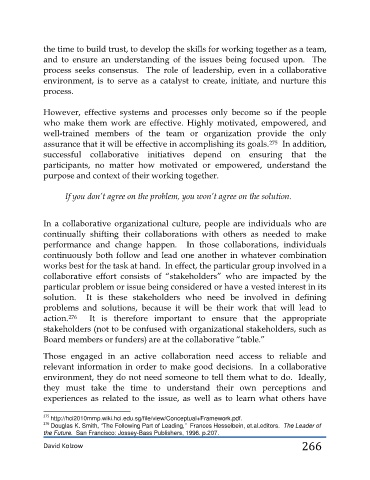Page 266 - 4- Leading_from_Within
P. 266
the time to build trust, to develop the skills for working together as a team,
and to ensure an understanding of the issues being focused upon. The
process seeks consensus. The role of leadership, even in a collaborative
environment, is to serve as a catalyst to create, initiate, and nurture this
process.
However, effective systems and processes only become so if the people
who make them work are effective. Highly motivated, empowered, and
well-trained members of the team or organization provide the only
assurance that it will be effective in accomplishing its goals. 275 In addition,
successful collaborative initiatives depend on ensuring that the
participants, no matter how motivated or empowered, understand the
purpose and context of their working together.
If you don’t agree on the problem, you won’t agree on the solution.
In a collaborative organizational culture, people are individuals who are
continually shifting their collaborations with others as needed to make
performance and change happen. In those collaborations, individuals
continuously both follow and lead one another in whatever combination
works best for the task at hand. In effect, the particular group involved in a
collaborative effort consists of “stakeholders” who are impacted by the
particular problem or issue being considered or have a vested interest in its
solution. It is these stakeholders who need be involved in defining
problems and solutions, because it will be their work that will lead to
action. It is therefore important to ensure that the appropriate
276
stakeholders (not to be confused with organizational stakeholders, such as
Board members or funders) are at the collaborative “table.”
Those engaged in an active collaboration need access to reliable and
relevant information in order to make good decisions. In a collaborative
environment, they do not need someone to tell them what to do. Ideally,
they must take the time to understand their own perceptions and
experiences as related to the issue, as well as to learn what others have
275 http://hci2010mmp.wiki.hci.edu.sg/file/view/Conceptual+Framework.pdf.
276 Douglas K. Smith, “The Following Part of Leading,” Frances Hesselbein, et.al.editors. The Leader of
the Future. San Francisco: Jossey-Bass Publishers, 1996. p.207.
David Kolzow 266

